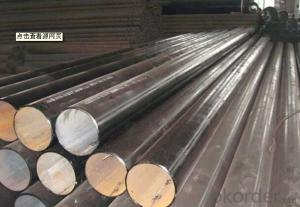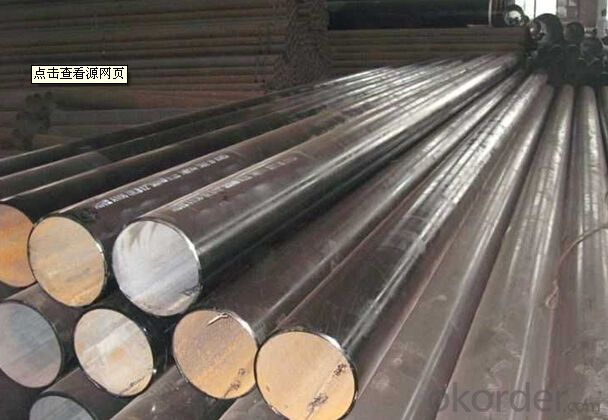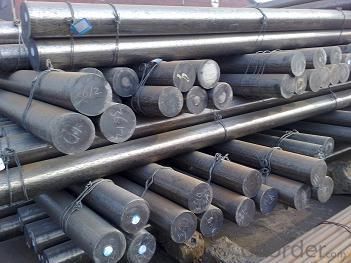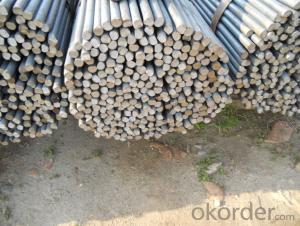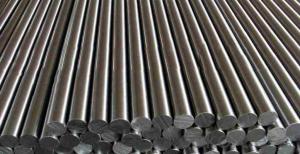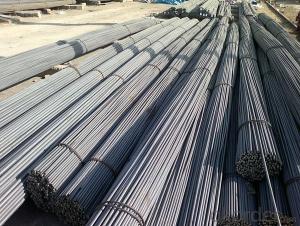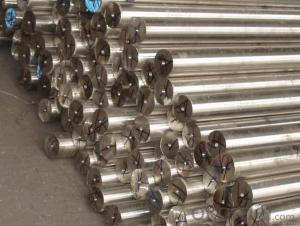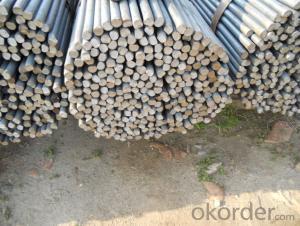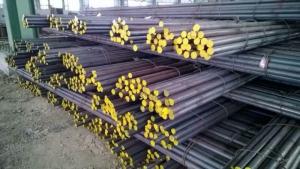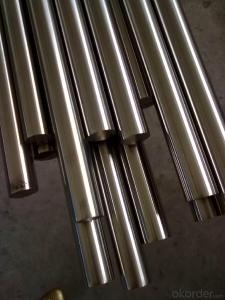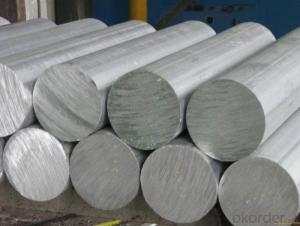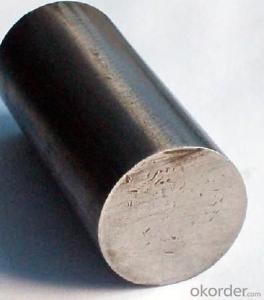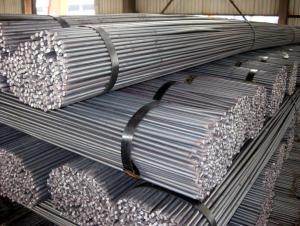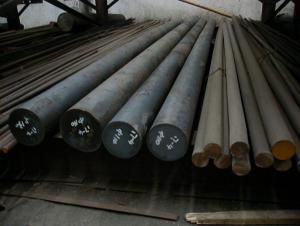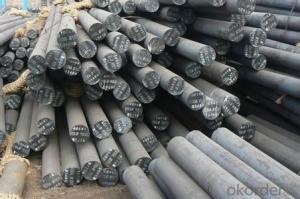Hot Rolled Steel Round Bar For Pipes Produce
- Loading Port:
- China main port
- Payment Terms:
- TT OR LC
- Min Order Qty:
- 25 m.t.
- Supply Capability:
- 5000 m.t./month
OKorder Service Pledge
OKorder Financial Service
You Might Also Like
Grade | AISI 52100, ASTM E52100, DIN 1.3505,JIS SUJ2, GCr15 |
Dimensions | Diameter: 30-60mm Length: 2000-13000mm or as required |
Shape | Round Bar |
Type | Alloy Steel Bar |
Delivery Condition | Black Surface |
Material | Bearing Steel |
Technique | Hot Rolled |
Usage and Applications
These steels are used for ball and roller bearing applications and are comprised of low carbon steels and high carbon through harden able steel.
First the famous 1C-1.5Cr steel from which the majority of bearings are made. Its structure is apparently well-understood and the focus is on purity in order to avoid inclusions which initiate fatigue during rolling contact. Then there is the M50 steel and its variants, from which bearings which serve at slightly higher temperatures in aeroengines are manufactured, based on secondary-hardened marten site.
Tapered roller bearing are generally used to support combined load mainly consisting of radial load. Their cups are separable for easy assembling ,During mounting and using, radial clearance and axial clearance can be adjusted and preloaded mounting can be made.
Packaging & Delivery
Packaging Detail: ASTM 52100 Steel in seaworthy packing or on customer request; Packed in bundles with standard export sea-worthy package or as customer require
Delivery Detail: 45 days after confirmed
Trade terms: FOB, CFR, CIF ou as customer's required
MOQ: 25 tons or at customer's demands. If the quantity is good, the price will be better.
Processing of Bearing Steel Round Bar
The processing of Bearing Steel Round Bar is hot rolled (strictly control sulphur, phosphorus and non-metallic inclusions content and distribution)
Chemical Composition of Bearing Steel Round Bar
C | Si | Mn | Cr | Ni | Cu |
Equal or less than | |||||
0.95-1.05 | 0.15-0.35 | 0.25-0.45 | Cr:1.40-1.65 | 0.30 | 0.25 |
All products' chemical composition and specification can be design according to customers' requirement.
Note
1. According to national standard (GB) for our products, if not, supply according to national standards (GB) or agreement.
2. We can not only provide electric furnace +LF+VD and electros lag re-melting (ESR) steel forging materials, but also forging products of piece, bar, etc.
3. Our company is equipped with roll equipment and can provide our customers with roll billets or finished.
4. Please send us your detailed specifications when inquire. We will reply to you ASAP.
5. Certificate of quality is issued in English, in addition the normal terms, production process, the mechanical property (yield strength, tensile strength, elongation and hardness. forged ratio, UT test result, Grain size, heat treatment methods and the sample of is shown on the certificate of quality.
- Q: What are the different welding techniques for steel round bars?
- Steel round bars can be welded using various techniques. Here are some commonly used ones: 1. Stick welding, also known as Shielded Metal Arc Welding (SMAW): This technique involves using an electrode coated in flux to create an electric arc between the electrode and the workpiece. The base metal melts, resulting in a weld. 2. Gas Metal Arc Welding (GMAW), commonly referred to as MIG (Metal Inert Gas) welding: In this technique, a wire electrode is fed through a welding gun. It combines with a shielding gas to create a weld. 3. Flux-Cored Arc Welding (FCAW): Similar to GMAW, FCAW uses a continuously fed electrode. However, instead of a solid wire electrode, it uses a tubular electrode filled with flux. This flux protects the weld and adds strength. 4. Tungsten Inert Gas (TIG) welding, also known as Gas Tungsten Arc Welding (GTAW): This precise technique involves using a non-consumable tungsten electrode to create an arc. Additional material may be added using a filler rod. 5. Submerged Arc Welding (SAW): This technique is suitable for heavy-duty applications, such as welding steel round bars for structural purposes. The arc and welding zone are submerged in granular flux, providing protection and deep penetration. Each technique has its advantages and is suitable for specific applications. Factors like round bar thickness, required weld strength, and accessibility of the welding site should be considered when selecting the appropriate technique for a strong and durable weld on steel round bars.
- Q: Can steel round bars be used for making sculptures?
- Certainly, sculptures can be created using steel round bars. Steel, being an adaptable and long-lasting material, can be shaped into diverse forms and figures. Round bars, in particular, are ideal for sculpting because they offer a sleek and curved aesthetic. Steel sculptures are recognized for their robustness, durability, and ability to endure various weather conditions, making them suitable for both indoor and outdoor installations. Furthermore, steel can be effortlessly welded, bent, and molded, providing artists with the opportunity to explore their artistic abilities and produce intricate designs. By employing proper techniques and expertise, steel round bars can be transformed into breathtaking sculptures that infuse any space with a contemporary and industrial flair.
- Q: What is the maximum elongation of steel round bars?
- The maximum elongation of steel round bars can vary depending on the specific grade and composition of the steel. However, in general, the maximum elongation for steel round bars is typically around 20-30% of its original length. This means that the steel round bar can stretch or elongate by up to 20-30% before reaching its breaking point or ultimate tensile strength. It is important to note that this maximum elongation is influenced by various factors such as the quality of the steel, the manufacturing process, and any heat treatment applied to the bars. Therefore, it is advisable to consult the specific manufacturer's specifications and consider the intended application of the steel round bars to determine the maximum elongation for a particular case.
- Q: What is the maximum silicon content allowed for steel round bars?
- The maximum silicon content allowed for steel round bars is typically around 0.35%.
- Q: How do you calculate the strength of a steel round bar?
- To calculate the strength of a steel round bar, several factors need to be considered. The primary factor is the material's yield strength, which represents the stress level at which the steel begins to deform permanently. This value is typically provided by the manufacturer or can be found in engineering handbooks. Next, the cross-sectional area of the round bar needs to be determined. This can be done by measuring the diameter of the bar and using it to calculate the area using the formula A = πr^2, where A is the cross-sectional area and r is the radius. Once the cross-sectional area is known, the ultimate tensile strength (UTS) can be calculated using the formula UTS = Yield Strength / Safety Factor. The safety factor is a numerical value that accounts for uncertainties and potential variations in the material's strength. It is typically specified by the design requirements or industry standards. Finally, the maximum load that the steel round bar can withstand before failure can be determined by multiplying the ultimate tensile strength by the cross-sectional area. This value represents the strength of the round bar and can be used to assess its suitability for a particular application. It is important to note that other factors such as the bar's length, shape, and any additional treatments or modifications can also affect its strength. Therefore, consulting with a structural engineer or referring to relevant design codes and standards is recommended to ensure accurate calculations and safe application of steel round bars.
- Q: Can steel round bars be used in the production of musical equipment?
- Yes, steel round bars can be used in the production of musical equipment. They can be utilized to create various components such as structural frames, supports, or even as part of the instrument itself. Steel is a versatile material known for its strength and durability, making it suitable for applications in the manufacturing of musical instruments.
- Q: What are the disadvantages of using steel round bars?
- Using steel round bars in certain applications has several drawbacks. Firstly, they are relatively heavy compared to materials like aluminum or plastic, which can be problematic when weight restrictions or easy transportation are important factors. Secondly, steel round bars are prone to corrosion, particularly in environments with high moisture, humidity, or exposure to certain chemicals. This can cause the material to degrade over time, reducing its strength and durability. To address this issue, additional measures such as coatings or regular maintenance may be necessary, increasing the overall cost and effort. Moreover, steel round bars may not be suitable for applications that require electrical insulation due to their conductivity. This can be a disadvantage when electrical conductivity needs to be avoided. Lastly, steel round bars may not be as visually appealing as materials like wood or decorative metals. While this may not be a significant drawback in some applications, it can be a disadvantage in situations where aesthetics are important, such as architectural or interior design projects. In conclusion, while steel round bars have widespread use and offer numerous advantages such as high strength and durability, it is crucial to consider these disadvantages in specific applications to ensure the most suitable choice of materials.
- Q: How do you determine the strength and hardness of a steel round bar?
- To assess the strength and hardness of a steel round bar, a variety of tests and techniques can be utilized. The tensile strength test is a frequently employed method. During this test, an increasing load is applied to a sample of the steel round bar until it reaches its breaking point. The maximum load it can endure before breaking is recorded, providing an indication of the bar's strength. Another essential measure of steel round bar quality is hardness testing. The Rockwell hardness test is commonly used, involving the pressing of a diamond or tungsten carbide ball into the bar's surface with a specific load. The depth of the resulting indentation is measured, and the hardness value is determined according to a standardized scale. Additionally, the Brinell hardness test can be employed, which entails pressing a hardened steel ball into the round bar's surface with a specific load. The diameter of the resulting indentation is measured, allowing for the calculation of hardness based on the applied load and indentation size. Furthermore, non-destructive techniques such as ultrasonic testing and magnetic particle inspection can offer insight into the steel round bar's internal structure, defects, and cracks, indirectly indicating its strength and hardness. It is crucial to acknowledge that various factors, including steel composition, heat treatment, and manufacturing processes, can influence the strength and hardness of a round bar. Therefore, consulting relevant standards and specifications that define the expected properties for the specific type of steel round bar being tested is advisable.
- Q: Can steel round bars be hardened through heat treatment?
- Yes, steel round bars can be hardened through heat treatment. Heat treatment is a process that involves heating the steel to a specific temperature and then rapidly cooling it to achieve the desired hardness and strength. There are different heat treatment methods, such as quenching and tempering, which can be used to harden steel round bars. Quenching involves heating the steel to a critical temperature and then rapidly cooling it in a liquid medium, such as oil or water, to achieve maximum hardness. Tempering, on the other hand, involves reheating the quenched steel to a lower temperature to reduce brittleness and improve toughness while maintaining a desirable hardness level. Heat treatment can significantly improve the mechanical properties of steel round bars, making them suitable for various applications that require high strength and hardness.
- Q: Can steel round bars be plated?
- Yes, steel round bars can be plated. Plating is a common process used to enhance the appearance and protect the surface of steel bars. The plating can be done using various materials such as chrome, nickel, or zinc, depending on the desired outcome and application of the steel bars. Plating can provide additional corrosion resistance, improve hardness or wear resistance, and also create an attractive finish. It is important to note that proper preparation and cleaning of the steel surface before plating is crucial to ensure a durable and high-quality plated finish.
Send your message to us
Hot Rolled Steel Round Bar For Pipes Produce
- Loading Port:
- China main port
- Payment Terms:
- TT OR LC
- Min Order Qty:
- 25 m.t.
- Supply Capability:
- 5000 m.t./month
OKorder Service Pledge
OKorder Financial Service
Similar products
Hot products
Hot Searches
Related keywords
